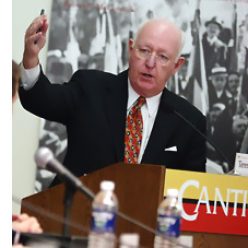On September 18, 2003, hurricane Isabel famously inundated not only the city dock and Main Street area of Annapolis, but much of the United States Naval Academy. The storm surge flooded 40 per cent of the lower Academy grounds and 22 of 40 buildings and caused some $80 million in damage.
Cleaning up after the waters receded, Sara G. Phillips, the Architect of the Naval Academy, could foresee the massive restoration project that would occupy the next couple of decades of her life.
“Isabel rang our bell,” she recalled recently, sitting in an Academy office as a gentle spring rain caused ponding in the parking lots outside. “It got our attention, and that of Congress.” Believe it or not, Congress actually acted, approving $80 million in three installments to clean up the mess.
In the years since, the Naval Academy has embarked on an ambitious flood mitigation scheme that will continue for decades and consume tens of millions of your federal tax dollars and mine. It is designed to protect the lower portion of “the Yard,” as the campus is called, against a 10.8-foot storm surge (Isabel’s reached 7.8-foot at its height) and preserve the buildings against gradual but unstoppable sea level rise.
The Academy will use a creative combination of sea walls, levees, berms and closures. Where necessary, entire buildings will be moved to dryer ground. An innovative system will capture storm water below ground and use it to irrigate athletic fields.
“We know there will be another Isabel,” Phillips said. “We want the Naval Academy to be here for the next generation.”
If only the city of Annapolis had heard Isabel’s ringing warning as clearly, it might have taken steps by now to protect downtown and the historic district against the next storm and the continuing threat of sea level rise. In contrast, in the 12 years since, commissions have been appointed, studies conducted, reports written, but no barriers built, no sea walls erected, no innovative schemes devised to hold mother nature at bay.
Most importantly, the public has not been engaged to the point of demanding meaningful action, despite scientific projections of anywhere between two-to-four feet of sea level rise in the coming decades.
So, where is the city now, a dozen years after Isabel?
The City Council has held hearings on the threat of sea level rise and Lisa Craig, the estimable chief of historic preservation for the city, has been beating the drum to arouse public interest.
And now, it seems, the ocean liner that is the city administration finally is beginning to turn. Ross Arnett, the Eastport Alderman, reports that funds are being appropriated for tidal flooding mitigation: $100,000 for matching grant money and studies in the upcoming budget, $1million in FY 2018 for sea wall and stormwater drain construction, $2million in FY 2019 and annually thereafter.
“It’s a start,” Arnett says, adding that he expects it will cost upwards of $10million to protect the most vulnerable downtown areas and even more to preserve Eastport against rising waters. “After years of lollygagging on this, we have a cordial and cooperative relationship with the Naval Academy and we’re making progress.”
“Weather It Together,” is the new city branding phrase, emphasizing, Lisa Craig says, “that residents, businesses, government, the Army Corps of Engineers and the Naval Academy have got to work together” to confront a shared, existential challenge. To this end, the Academy is taking the lead in forming a Sea Level Advisory Council to coordinate efforts.
“We’ve got to look at the problem holistically, the Academy and city and state have a shared problem and need a shared solution,” Sara Phillips says. Clearly, rising water has to go somewhere and it won’t do to have the Academy protected, say, and the city vulnerable.
The harsh alternative to joint and coordinated action is the inevitable destruction of the city’s historic core, perhaps the greatest collection of 18th century homes and structures in the United States. Two weeks ago in this space, Will Marshall argued persuasively that Annapolis’s economic survival depends upon protecting it against the rising tides. I would add that its culture and identity depend on it as well.
